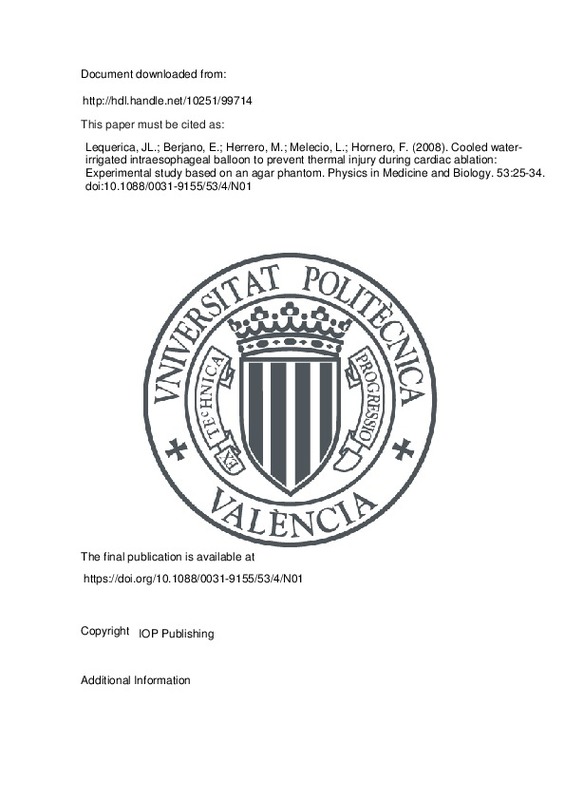JavaScript is disabled for your browser. Some features of this site may not work without it.
Buscar en RiuNet
Listar
Mi cuenta
Estadísticas
Ayuda RiuNet
Admin. UPV
Cooled water-irrigated intraesophageal balloon to prevent thermal injury during cardiac ablation: Experimental study based on an agar phantom
Mostrar el registro sencillo del ítem
Ficheros en el ítem
| dc.contributor.author | Lequerica, Juan L.
|
es_ES |
| dc.contributor.author | Berjano, Enrique
|
es_ES |
| dc.contributor.author | Herrero, Maria
|
es_ES |
| dc.contributor.author | Melecio, Lemuel
|
es_ES |
| dc.contributor.author | Hornero, Fernando
|
es_ES |
| dc.date.accessioned | 2018-03-25T04:23:03Z | |
| dc.date.available | 2018-03-25T04:23:03Z | |
| dc.date.issued | 2008 | es_ES |
| dc.identifier.issn | 0031-9155 | es_ES |
| dc.identifier.uri | http://hdl.handle.net/10251/99714 | |
| dc.description.abstract | [EN] A great deal of current research is directed to finding a way to minimize thermal injury in the esophagus during radiofrequency catheter ablation of the atrium. A recent clinical study employing a cooling intraesophageal balloon reported a reduction of the temperature in the esophageal lumen. However, it could not be determined whether the deeper muscular layer of the esophagus was cooled enough to prevent injury. We built a model based on an agar phantom in order to experimentally study the thermal behavior of this balloon by measuring the temperature not only on the balloon, but also at a hypothetical point between the esophageal lumen and myocardium (2 mm distant). Controlled temperature (55 degrees C) ablations were conducted for 120 s. The results showed that (1) the cooling balloon provides a reduction in the final temperature reached, both on the balloon surface and at a distance of 2 mm; (2) coolant temperature has a significant effect on the temperature measured at 2 mm from the esophageal lumen (it has a less effect on the temperature measured on the balloon surface) and (3) the pre- cooling period has a significant effect on the temperature measured on the balloon surface (the effect on the temperaturemeasured 2mmaway is small). The results were in good agreement with those obtained in a previous clinical study. The study suggests that the cooling balloon gives thermal protection to the esophagus when a minimum pre- cooling period of 2 min is programmed at a coolant temperature of 5 degrees C or less. | es_ES |
| dc.description.sponsorship | We would like to thank the R+D+i Linguistic Assistance Office at the Technical Universityof Valencia for their help in revising this paper. This work was partially financially supported by the ‘Plan Nacional de Investigación Científica, Desarrollo e Innovación Tecnológica del Ministerio de Educación y Ciencia of Spain (TEC 2005-04199/TCM) and by an R&D contract (CSIC-20060633) between Edwards Life science Ltd. and the Spanish Council for ScientificResearch (CSIC). | es_ES |
| dc.language | Inglés | es_ES |
| dc.publisher | IOP Publishing | es_ES |
| dc.relation.ispartof | Physics in Medicine and Biology | es_ES |
| dc.rights | Reserva de todos los derechos | es_ES |
| dc.subject.classification | TECNOLOGIA ELECTRONICA | es_ES |
| dc.title | Cooled water-irrigated intraesophageal balloon to prevent thermal injury during cardiac ablation: Experimental study based on an agar phantom | es_ES |
| dc.type | Artículo | es_ES |
| dc.identifier.doi | 10.1088/0031-9155/53/4/N01 | es_ES |
| dc.relation.projectID | info:eu-repo/grantAgreement/MEC//TEC2005-04199/ES/MODELOS TEORICOS Y COMPUTACION AVANZADA EN EL ESTUDIO DE SEÑALES BIOELECTRICAS EN CELULAS Y TEJIDOS. IMPLICACIONES EN EL ANALISIS DE ARRITMIAS CARDIACAS, ELECTROESTIMULACION Y ABLACION POR RADIOFRECUENCIA/ | es_ES |
| dc.relation.projectID | info:eu-repo/grantAgreement/CSIC//20060633/ | es_ES |
| dc.rights.accessRights | Abierto | es_ES |
| dc.contributor.affiliation | Universitat Politècnica de València. Departamento de Ingeniería Electrónica - Departament d'Enginyeria Electrònica | es_ES |
| dc.description.bibliographicCitation | Lequerica, JL.; Berjano, E.; Herrero, M.; Melecio, L.; Hornero, F. (2008). Cooled water-irrigated intraesophageal balloon to prevent thermal injury during cardiac ablation: Experimental study based on an agar phantom. Physics in Medicine and Biology. 53:25-34. https://doi.org/10.1088/0031-9155/53/4/N01 | es_ES |
| dc.description.accrualMethod | S | es_ES |
| dc.relation.publisherversion | https://doi.org/10.1088/0031-9155/53/4/N01 | es_ES |
| dc.description.upvformatpinicio | 25 | es_ES |
| dc.description.upvformatpfin | 34 | es_ES |
| dc.type.version | info:eu-repo/semantics/publishedVersion | es_ES |
| dc.description.volume | 53 | es_ES |
| dc.relation.pasarela | S\31954 | es_ES |
| dc.contributor.funder | Ministerio de Educación y Ciencia | es_ES |
| dc.contributor.funder | Consejo Superior de Investigaciones Científicas | es_ES |







![[Cerrado]](/themes/UPV/images/candado.png)

